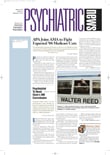America may be the “land of the free and the home of the brave,” as the old saying goes, but it may also be the land of widespread child maltreatment.
So suggests a new study conducted not just on a large community sample, but on people who were largely well educated and well off financially. If the study had been conducted on an even more diverse community population, child mishandling may well have been found to be even more prevalent.
The study was headed by Valerie Edwards, Ph.D., of the Centers for Disease Control and Prevention in Atlanta. The results appeared in the August American Journal of Psychiatry.
A decade ago, an investigation called the Adverse Childhood Experiences Study was launched at a large city health maintenance organization (HMO) to examine the associations between childhood maltreatment, family dysfunction, and adult health outcomes. Almost 13,500 HMO members first underwent a physical exam for the study. Of these, about 8,500 filled out a 162-item family health history questionnaire that included questions about childhood maltreatment and exposure to family dysfunction, as well as current health behaviors and conditions.
Childhood sexual abuse was assessed with four questions adapted from a questionnaire that covered fondling, attempted intercourse, and intercourse. Respondents who gave an affirmative answer to any of the four items were classified as sexually abused.
Childhood physical abuse was assessed with two items adapted from the Conflict Tactics Scale. Respondents who indicated that they had been pushed, grabbed, shoved, slapped, or had something thrown at them “often” or “very often” or who indicated that they had been hit so hard that they had marks or were injured “once” or “more than once” were considered victims of childhood physical abuse.
Being a witness of maternal battering was assessed with four items adapted from the Conflict Tactics Scale relating to having seen their mother being pushed, grabbed, or slapped or having something thrown at her.
The intensity of emotional abuse in the childhood family environment was assessed with the emotional abuse subscale of the short form of the Childhood Trauma Questionnaire.
Women made up a little more than half of the questionnaire respondents. Almost three-fourths of the respondents were white, 11 percent Hispanic, 8 percent Asian, and 4 percent African American. More than three-fourths of the respondents had some college education. Of the 8,500 HMO members who filled out the family health history questionnaire, some 7,500 also completed the Medical Outcomes Study 36-item Short-Form Health Survey to assess their current mental health status.
Now, Edwards and her coworkers have tapped questionnaire and survey responses from these some 7,500 subjects to answer three questions: How many had been maltreated as children, whether those who had been mishandled had experienced more than one kind of mishandling, and whether there was a dose response between being handled improperly as a child and one’s adult mental health status.
A disturbingly large number of the 7,500 subjects—43 percent—reported having been maltreated in the areas under study: physical abuse, sexual abuse, and/or witnessing maternal battering, the researchers found. Specifically, 22 percent reported having been sexually abused, 21 percent reported having been physically abused, and 14 percent reported having witnessed maternal battering. And while more women than men reported having been sexually abused (25 percent versus 18 percent), more men than women reported having been physically abused (22 percent versus 20 percent).
The investigators also made the troubling discovery that more than one-third of the 43 percent of respondents reported having been maltreated in more than one manner as a child. For example, of the 25 percent of women who reported having been sexually abused, more than half (14 percent) also reported having experienced at least one additional form of abuse. Similarly, of the 22 percent of men who had reported having been physically abused, about half (11 percent) also reported having been sexually abused, witnessing maternal battering, or both.
The researchers also looked to see whether having been maltreated as a child had a negative impact on adult mental health in a dose-response manner. The answer was essentially yes, they found. For instance, 7 percent of men who reported having witnessed maternal battering, 10 percent who reported having witnessed maternal battering plus having been physically or sexually abused, and 16 percent who reported having witnessed maternal battering plus having been physically and sexually abused had a low mental health score as an adult. Similarly, 14 percent of women who reported having witnessed maternal battering, 19 percent who reported having witnessed maternal battering plus having been physically or sexually abused, and 20 percent who reported having witnessed maternal battering plus having been physically and sexually abused had a low mental health score as an adult.
“The overwhelming majority of the [study] participants were white and had at least some college education,” Edwards and her team wrote in their study report, “hence additional studies should be performed to confirm these findings with more demographically diverse groups. Even higher abuse prevalences may have been obtained had a more diverse group of respondents been included.”
The study was financed by the Centers for Disease Control and Prevention, the Association of Teachers of Preventive Medicine, and the Garfield Memorial Fund.
Am J Psychiatry 2003 160 1453
